SEO or AdWords? What is more profitable for a b2b company in 2017
The task is as follows: there is a website layout company. The budget is about $ 25,000. The business owner is interested in returning investments in SEO and AdWords.
At first, it is difficult to compare these channels to attract customers. For example, the results of SEO-promotion come in weeks and months, but contextual advertising can be analyzed and optimized almost immediately. Nevertheless, there are measurable indicators: the amount of investment, the number of unique visitors, conversion, the number of transactions with customers, the profit from such transactions.
First, let's take a look at the general picture of attendance for the last 3 months.
')
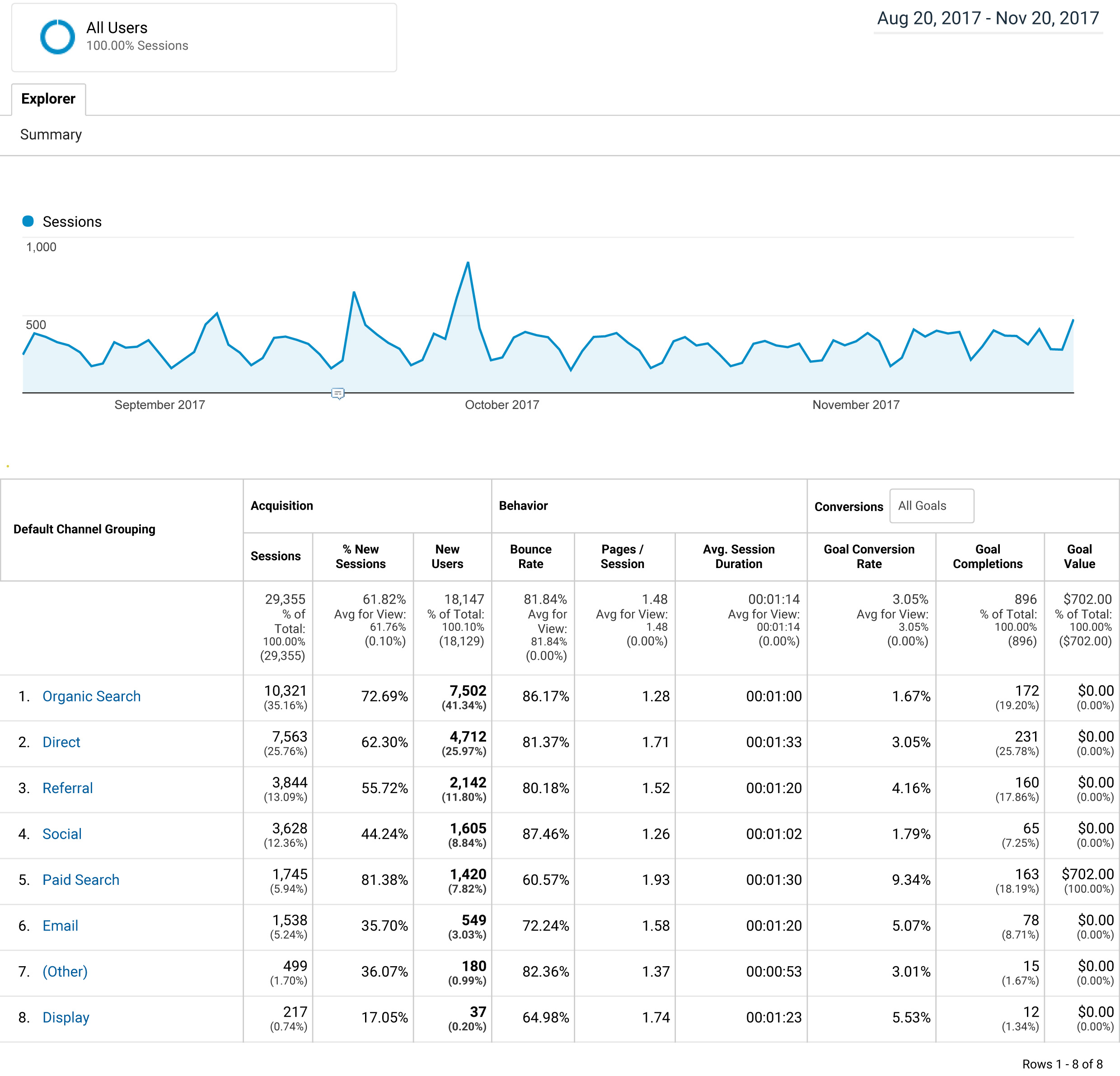
SEO is the largest channel for attracting visitors. A high bounce rate immediately catches the eye. And it is high both for visitors from social networks, and for those who came through referral links. Based on this indicator, the conclusion suggests itself that, on average, 8 out of 10 visitors find the contents of the main page not relevant to their interests. For a company that has been in the market for more than 4 years, this looks strange.
The reason is that the company focuses on orders from medium and large customers, and does not work with entrepreneurs and small businesses. Those. The main target audience is corporate customers or medium / large business, regularly ordering layout and update projects. One-time orders for the layout of the site are not interesting to the business owner.
Accordingly, the working conditions and pricing policies are focused on medium and large companies. This explains the fact that 86% of visitors do not find the site useful. The average time spent by a visitor who came from a search engine in a natural way is 1 minute. Those. the visitor came to the site, for a minute, got acquainted with the conditions, the price, found them unsuitable and left. This happens because 8 out of 10 visitor sites that are interested in layout are customers who are not the target audience. Such specificity of the company's business.
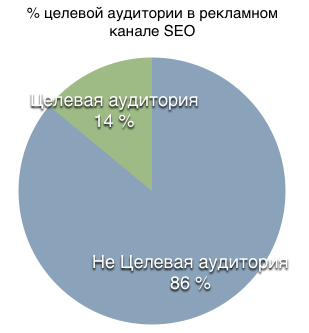
What can you do in this situation? Nothing. This is the effectiveness of the channel to attract customers. It remains to take as an axiom the fact that most of the traffic on the topic of website layout is generated by entrepreneurs and small business representatives, and the majority of visitors will by definition be useless. Both in SEO, and in contextual advertising, social networks, etc. This means that the conversion and the profit from orders will be calculated with very low coefficients.
In our case, the task of SEO is not generating massive traffic or reaching a wide audience. SEO is used to attract and establish contact with corporate customers. And the main role in this is played by articles in thematic blogs and profile resources. Those. The criterion of SEO efficiency is the readability of articles and guest posts on third-party resources by representatives of medium and large businesses, the number of transitions from third-party resources, conversion, the number of orders.
The next question is in choosing a point of reference. The graph of attendance on the channel Organic Search shows that a significant increase in attendance begins in mid-July 2017. Accordingly, we are interested in July-November 2017.
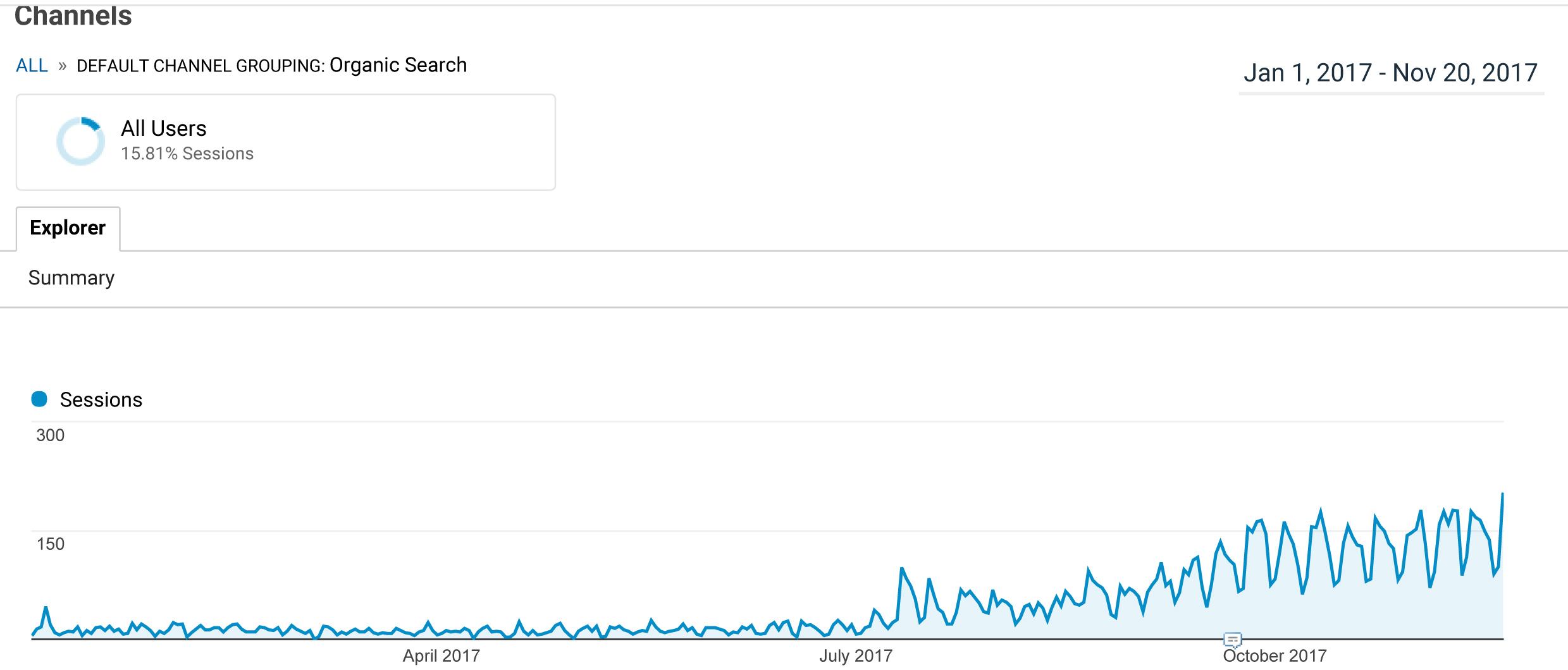
Also to SEO, we refer the transitions to our site from third-party resources. On the attendance graph on the Referals channel, attendance increased at the beginning of July 2017.
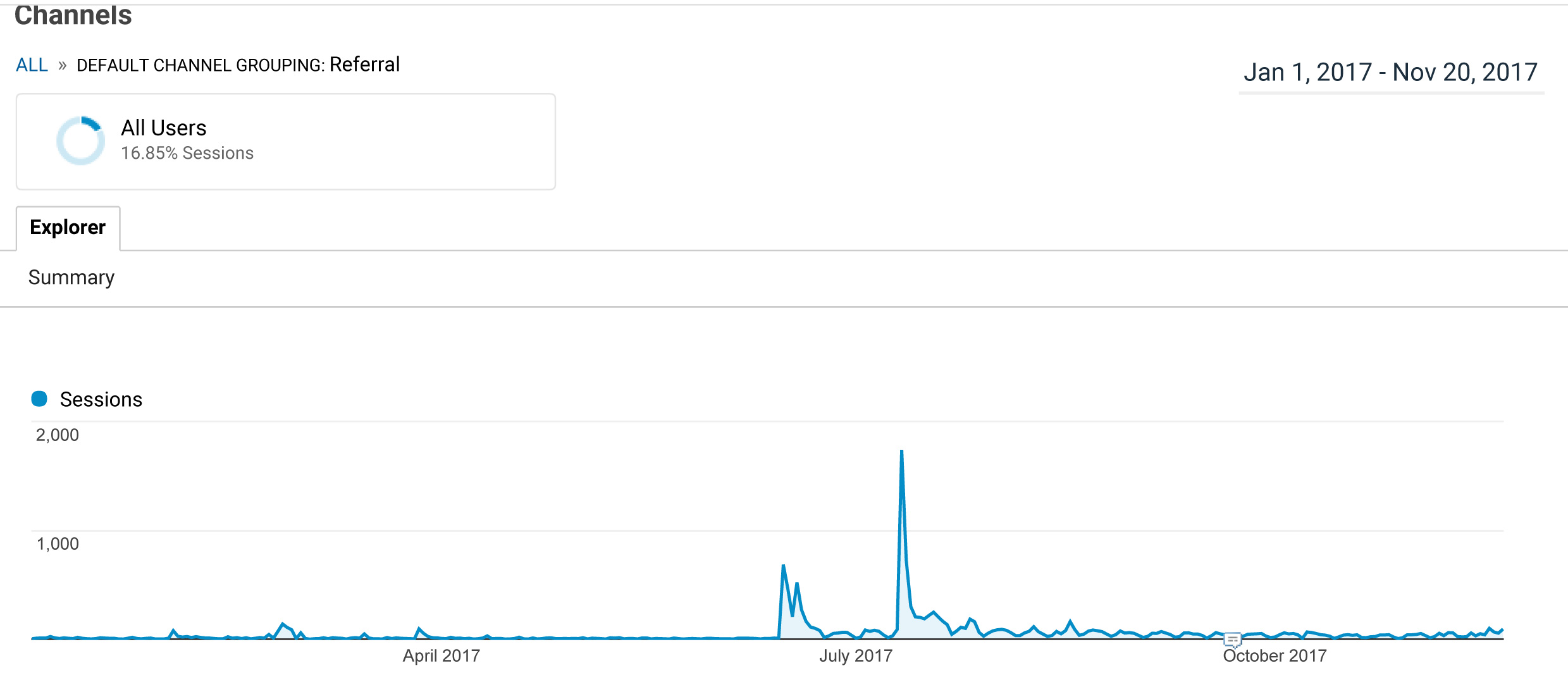
If you superimpose 2 schedules on each other, we will see that within 14 days from the start of posting articles and guest posts, the site’s natural traffic begins to grow. The beginning of the growth of natural attendance accounted for the indexation of the second article posted on a third-party resource.

Total expenses for SEO promotion, we include:
- payment for writing articles and guest posts
- payment for placing publications and guest posts on third-party resources

Attendance on paid AdWords advertising channel, we will take for the same period of time July 1 - November 20.
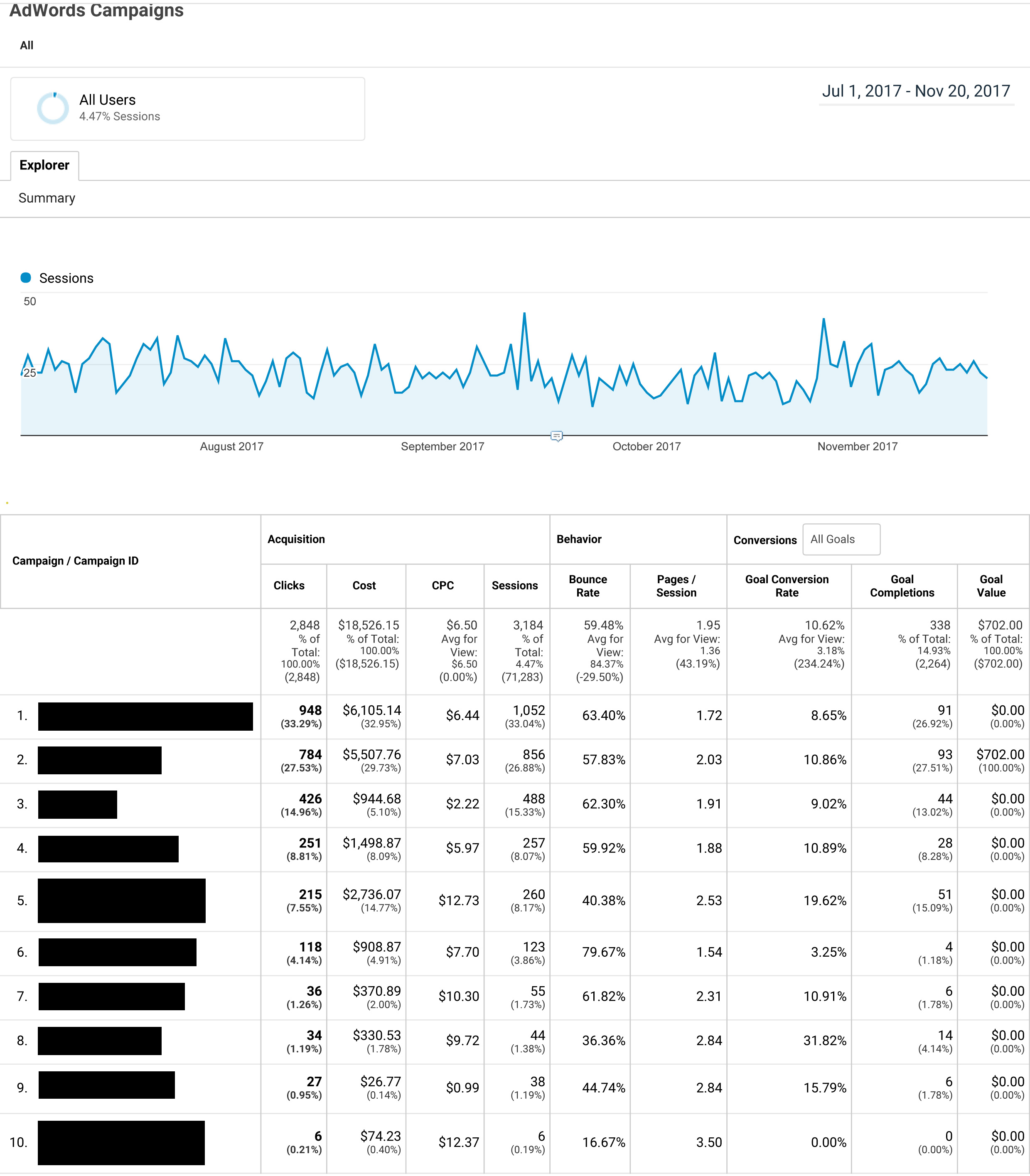
Bounce Rate is here below. Average number of page views above. However, on average, 6 out of 10 visitors are not the target audience.
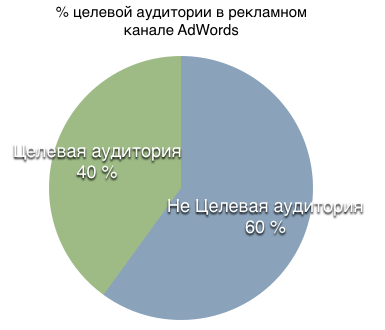
Based on the table data, it is not difficult to calculate the average cost of attracting a visitor to the landing page, the cost of getting 1 order, and other parameters. In the past analytical review, we have already done such calculations, if you are interested you can read here .
In this case, it does not make sense to consider such parameters. In conditions when the majority of visitors by definition cannot be a company's customers, these figures will indicate that the choice of a channel to attract customers is not optimal. Instead, we will immediately analyze the CRM and see the number of real orders with site visitors, their profitability.
Here another question arises - how to distinguish the target visitor from the non-target? If the visitor has gone to the page of filling out the order form - we will assume that a representative of a medium or large business did. Otherwise, the visitor will leave the site immediately and will not go to other pages.
For SEO, we’ll summarize our goals through Ogranic + Referals. The goal is to go to the order form filling page, call or email. For tracking calls and emails, special plug-ins are installed in CRM.

According to the table, SEO results: Of the 332 visitors who reached the order page, 171 visitors filled out an order form. 19 visitors made a call. 27 sent emails. Conversion is 65%.
AdWords Results: Of the 163 visitors to the order page, 119 filled out the order form, 6 visitors made a call and 11 sent emails. Conversion is 83%.

For clarity, visualize this data.

It turns out to use SEO to collect orders 3 times cheaper than in AdWords.
In addition, we check whether there are visitors who came to the site and on the search results, and paid advertising. To do this, view the behavior of users on the path to conversion (conversion paths).


If the user navigated to the site for each of the channels, we count the last channel which led to the conversion. Accordingly, the attribution model uses the last interaction.
To analyze transactions, we use export of sales statistics from CRM to datawrapper.
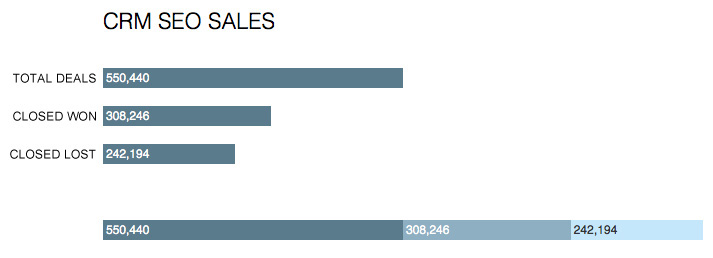
Visitors via the SEO channel sent 198 applications for the layout. In 56% of cases, orders were damaged. The total profit from orders received was $ 308,246. In 44% of cases, applications were not paid for various reasons. Unconfirmed orders could bring the company $ 242,194.

AdWords paid advertising channel: 127 applications for the layout. 71% of confirmed orders. The total profit is $ 281,871. 29% of unpaid bids in the amount of $ 115.131.
Next, we calculate the potential earnings and profits, taking into account the cost of advertising for each of the channels to attract customers.

Conclusion: in terms of minimum cost-maximum profit, the use of SEO is 4 times more profitable than contextual AdWords advertising. Or rather, not the entire search engine optimization, but a specific direction - the publication of articles and guest posts in thematic blogs.
* - meaning profit without taking into account costs (office rent, staff salary, equipment, etc.)
In our case, both SEO and AdWords are payable and profitable channels to attract customers. From the point of view of the cost of attracting a targeted SEO visitor, it is more profitable than AdWords. In terms of return on investment, using SEO is 4 times more profitable. However, such promotion takes time. You need to write or order an article, agree on placement, wait for indexation, etc. All this takes time and in practice articles are published about 2 times a month.
Nevertheless, if you look at the situation globally, both SEO and AdWords are not the most effective channels to attract visitors if the company seeks to work with representatives of large and medium-sized businesses. Taking into account the fact that in the SEO channel about 14% of the target audience, and in the AdWords channel about 40% most of the advertising budget is spent on increasing site traffic by not targeted visitors.
For example, at a thematic conference of 100 people 70-80 may be representatives of large or medium-sized businesses. In this channel, attracting customers already 70-80% of the target audience.
At first, it is difficult to compare these channels to attract customers. For example, the results of SEO-promotion come in weeks and months, but contextual advertising can be analyzed and optimized almost immediately. Nevertheless, there are measurable indicators: the amount of investment, the number of unique visitors, conversion, the number of transactions with customers, the profit from such transactions.
Part 1. Analysis of site traffic
First, let's take a look at the general picture of attendance for the last 3 months.
')

SEO is the largest channel for attracting visitors. A high bounce rate immediately catches the eye. And it is high both for visitors from social networks, and for those who came through referral links. Based on this indicator, the conclusion suggests itself that, on average, 8 out of 10 visitors find the contents of the main page not relevant to their interests. For a company that has been in the market for more than 4 years, this looks strange.
The reason is that the company focuses on orders from medium and large customers, and does not work with entrepreneurs and small businesses. Those. The main target audience is corporate customers or medium / large business, regularly ordering layout and update projects. One-time orders for the layout of the site are not interesting to the business owner.
Accordingly, the working conditions and pricing policies are focused on medium and large companies. This explains the fact that 86% of visitors do not find the site useful. The average time spent by a visitor who came from a search engine in a natural way is 1 minute. Those. the visitor came to the site, for a minute, got acquainted with the conditions, the price, found them unsuitable and left. This happens because 8 out of 10 visitor sites that are interested in layout are customers who are not the target audience. Such specificity of the company's business.

What can you do in this situation? Nothing. This is the effectiveness of the channel to attract customers. It remains to take as an axiom the fact that most of the traffic on the topic of website layout is generated by entrepreneurs and small business representatives, and the majority of visitors will by definition be useless. Both in SEO, and in contextual advertising, social networks, etc. This means that the conversion and the profit from orders will be calculated with very low coefficients.
In our case, the task of SEO is not generating massive traffic or reaching a wide audience. SEO is used to attract and establish contact with corporate customers. And the main role in this is played by articles in thematic blogs and profile resources. Those. The criterion of SEO efficiency is the readability of articles and guest posts on third-party resources by representatives of medium and large businesses, the number of transitions from third-party resources, conversion, the number of orders.
The next question is in choosing a point of reference. The graph of attendance on the channel Organic Search shows that a significant increase in attendance begins in mid-July 2017. Accordingly, we are interested in July-November 2017.

Also to SEO, we refer the transitions to our site from third-party resources. On the attendance graph on the Referals channel, attendance increased at the beginning of July 2017.

If you superimpose 2 schedules on each other, we will see that within 14 days from the start of posting articles and guest posts, the site’s natural traffic begins to grow. The beginning of the growth of natural attendance accounted for the indexation of the second article posted on a third-party resource.

Total expenses for SEO promotion, we include:
- payment for writing articles and guest posts
- payment for placing publications and guest posts on third-party resources

Part 2. Analyzing AdWords
Attendance on paid AdWords advertising channel, we will take for the same period of time July 1 - November 20.

Bounce Rate is here below. Average number of page views above. However, on average, 6 out of 10 visitors are not the target audience.

Based on the table data, it is not difficult to calculate the average cost of attracting a visitor to the landing page, the cost of getting 1 order, and other parameters. In the past analytical review, we have already done such calculations, if you are interested you can read here .
In this case, it does not make sense to consider such parameters. In conditions when the majority of visitors by definition cannot be a company's customers, these figures will indicate that the choice of a channel to attract customers is not optimal. Instead, we will immediately analyze the CRM and see the number of real orders with site visitors, their profitability.
Here another question arises - how to distinguish the target visitor from the non-target? If the visitor has gone to the page of filling out the order form - we will assume that a representative of a medium or large business did. Otherwise, the visitor will leave the site immediately and will not go to other pages.
For SEO, we’ll summarize our goals through Ogranic + Referals. The goal is to go to the order form filling page, call or email. For tracking calls and emails, special plug-ins are installed in CRM.

According to the table, SEO results: Of the 332 visitors who reached the order page, 171 visitors filled out an order form. 19 visitors made a call. 27 sent emails. Conversion is 65%.
AdWords Results: Of the 163 visitors to the order page, 119 filled out the order form, 6 visitors made a call and 11 sent emails. Conversion is 83%.

For clarity, visualize this data.

It turns out to use SEO to collect orders 3 times cheaper than in AdWords.
In addition, we check whether there are visitors who came to the site and on the search results, and paid advertising. To do this, view the behavior of users on the path to conversion (conversion paths).


If the user navigated to the site for each of the channels, we count the last channel which led to the conversion. Accordingly, the attribution model uses the last interaction.
Part 3. Analyzing CRM
To analyze transactions, we use export of sales statistics from CRM to datawrapper.

Visitors via the SEO channel sent 198 applications for the layout. In 56% of cases, orders were damaged. The total profit from orders received was $ 308,246. In 44% of cases, applications were not paid for various reasons. Unconfirmed orders could bring the company $ 242,194.

AdWords paid advertising channel: 127 applications for the layout. 71% of confirmed orders. The total profit is $ 281,871. 29% of unpaid bids in the amount of $ 115.131.
Next, we calculate the potential earnings and profits, taking into account the cost of advertising for each of the channels to attract customers.

Conclusion: in terms of minimum cost-maximum profit, the use of SEO is 4 times more profitable than contextual AdWords advertising. Or rather, not the entire search engine optimization, but a specific direction - the publication of articles and guest posts in thematic blogs.
* - meaning profit without taking into account costs (office rent, staff salary, equipment, etc.)
Part 4. Conclusions
In our case, both SEO and AdWords are payable and profitable channels to attract customers. From the point of view of the cost of attracting a targeted SEO visitor, it is more profitable than AdWords. In terms of return on investment, using SEO is 4 times more profitable. However, such promotion takes time. You need to write or order an article, agree on placement, wait for indexation, etc. All this takes time and in practice articles are published about 2 times a month.
Nevertheless, if you look at the situation globally, both SEO and AdWords are not the most effective channels to attract visitors if the company seeks to work with representatives of large and medium-sized businesses. Taking into account the fact that in the SEO channel about 14% of the target audience, and in the AdWords channel about 40% most of the advertising budget is spent on increasing site traffic by not targeted visitors.
For example, at a thematic conference of 100 people 70-80 may be representatives of large or medium-sized businesses. In this channel, attracting customers already 70-80% of the target audience.
Source: https://habr.com/ru/post/344190/
All Articles